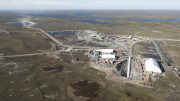The following is an edited version of a commentary by Surbiton Associates, an independent consulting group based in Melbourne and specializing in Australian gold mining and minerals industries. Visit www.surbiton.com.au for more information.
Merger and acquisition activity in recent years has caused a shake-up in the league table of companies producing gold in Australia. A new breed of locally based, mid-tier gold producers is emerging.
Newmont Mining remains the largest producer overall, with an annual output of around 1.5 million oz. gold, while Newcrest Mining, Australia’s largest Australian Securities Exchange-listed gold miner, produces some 1.1 million oz. gold annually from its Australian mines.
Gold production in Australia is still dominated by a few large overseas companies. However, as some have sold down their Australian assets in order to reduce debt, the mid-tier Australian gold producers have taken the opportunity to increase the number of gold mines they own and lift their overall output.
In late July Evolution Mining completed the purchase of Barrick Gold’s Cowal gold mine in New South Wales at a cost of US$550 million. This followed the acquisition of La Mancha’s Frog’s Leg and While Foil mines and its more than 100,000 oz. per annum Mungari treatment plant, near Kalgoorlie.
Northern Star Resources has also been an aggressive acquirer, buying first the Paulsens gold mine in 2010, and then buying the Plutonic, Kanowna Belle and 51% of the Kundana gold operations in Western Australia from Barrick in February 2014. It then acquired the Jundee operation from Newmont in July of that year.
With the recent acquisitions by companies like Evolution and Northern Star, overseas control of the gold mining industry has slipped below 50%.
Overseas control of Australia’s gold mining industry was around 20% until 1997, which was the year that saw Australia’s highest-ever gold production. There followed a period of escalating takeover activity, when the Australian dollar was weak and overseas control rose to 30% by mid-2001, then up to 60% by early 2002, before reaching a maximum of 70% in 2003.
In recent years, due to increased production by Australian companies and the divestment of some local operations by overseas companies, the percentage of overseas control has declined to its present level.
Surbiton’s estimated 2015 rankings, based on calendar 2014 output, leaves Newmont as the top producer, followed by Newcrest, then Gold Fields with 920,000 oz., Evolution with 840,000 oz. and Northern Star with 600,000 oz. (gold produced from their Australian operations only, excluding output from any overseas mines).
In Surbiton’s view, probably the greatest problem the rapidly growing Australian mid-tier producers face is the integration of so many geographically and geologically different operations under one single corporate structure.
Regarding the gold price, Surbiton sees local producers once again reaping the benefits of the lower Australian dollar versus U.S. currency. The Australian dollar gold price has remained relatively stable — averaging more than A$1,500 per oz. since the beginning of the year — whereas the US$ gold price has fallen to below US$1,100 recently.





Be the first to comment on "Facts ‘n’ Figures: Surbiton – Aussie M&A shakes up production rankings"